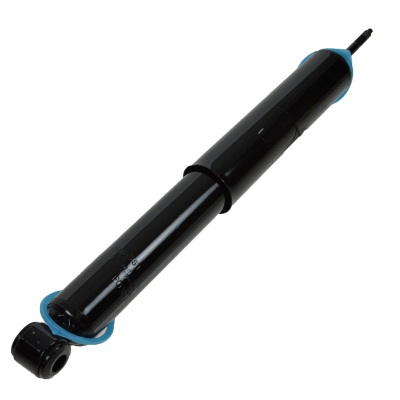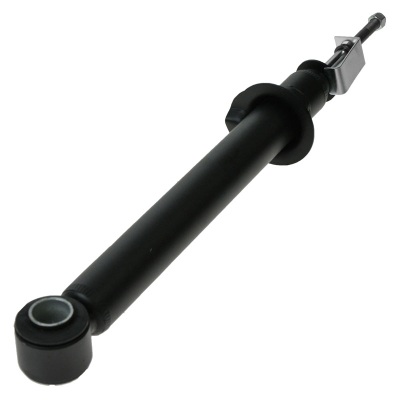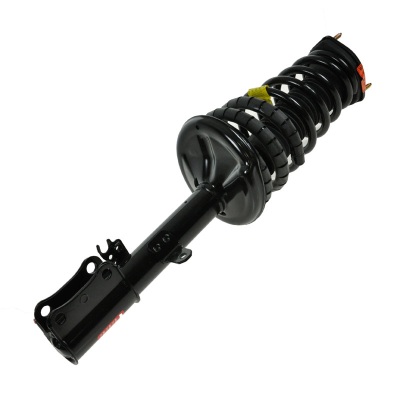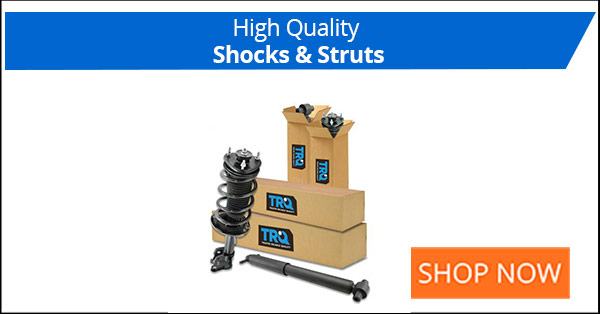Shocks vs. Struts
Shocks vs. Struts vs. Coilovers vs. Air Suspension
One of the great things about replacing worn out shocks and struts is the amazing satisfaction that you'll have when you are done. It often makes an old vehicle feel like a brand new car again. Very few auto parts will give you such a noticeable difference from before to after the repair.
Fifteen years ago, we could say that shocks are used on full-frame cars and trucks and struts are used on unibody vehicles. Today that is totally false. With the innovative newer suspension designs, there is not one definitive type of vehicle that struts, shocks, coil-overs, or air suspension are used on.
What's even more challenging is that coil-over shocks look so much like struts that they are easily confused with each other. Luckily, 1A Auto is here to help sort it all out so that you understand the difference between shocks and struts, how to identify each, what the different types of shocks and struts are, and much more!
What Are Shocks? - "The Basics"

The word "shock" is really the shortened version of "shock absorber." As you can probably guess, a shock absorber absorbs energy. As the car or truck rolls over bumps in the road, all of that oscillating suspension energy is absorbed into the shock. The shock does this with the combination of oil and a series of internal valves. Since the oil can only flow through these valves at a certain rate, the suspension movement becomes slower, smoother, and infinitely more predictable. Without shocks, the wheels on the car or truck will actually bounce off of the road surface and vibrate erratically down rough roads. As you can imagine, if the tires are not evenly touching the pavement at all times, the vehicle becomes unstable, and can actually be quite dangerous.
While shocks are extremely important for ride quality and safety, they are not an integral part of the suspension. They can be removed completely, and the car or truck will still be able to drive around (though it would feel like a rollercoaster ride).
As with everything in life, with age comes deterioration. When the shocks become old, the oil inside the shocks often leaks out, which means their dampening qualities are completely lost. Once this happens, the shock might as well not even exist. It is just along for the ride until somebody replaces it.
What Are Coilover Shocks (Not Struts)?

Coilover shocks are one of the biggest areas of confusion because so many people incorrectly identify them as "struts" when they are not. This happens because their upper halves, with the coil spring mounted on top, look extremely similar to struts. Their bottom, on the other hand, is a very different design.
Technically, the reason that a Coilover shock is not a strut is that it is not an integral part of the suspension. If you were to remove a set of Coilover shocks from a car, the coil springs would come out with them, and the car would basically fall to the ground with ultimate lowness.
Now, even with the Coilover shocks missing, the wheels would still be attached perfectly to the vehicle, because of the multi-link or conventional upper and lower A-arm suspension. The vehicle would also still be able to steer, though the tires would likely be scraping a few things.
What Are Struts?

Struts are very similar to shocks internally by having oil and valves, but they are constructed differently on the exterior. You see, struts are designed to be an integral part of the suspension. Unlike shocks, if the struts weren't attached, the car would fall flat on the ground, making it immobile. The wheels would flop around because they would only be attached to the lower control arm, which just isn't enough.
In large, all MacPherson struts will have a coil spring around them. The one exception is vehicles equipped with a modified MacPherson suspension where the spring is located inboard of the strut, most notably used on the 79-93 Fox-body Mustangs. On a typical strut, above the coil-spring is what is known as the upper strut mount, and under that is usually a bump-stop which is covered by a rubber boot. These pieces can all be replaced individually, or replaced together as one unit called a "loaded strut". Replacing a loaded strut on a vehicle is dramatically easier than replacing any one of the individual parts because you don't need to compress the coil springs, or align the strut mounts properly. It is all done for you.
Some struts have replaceable "cartridges". A cartridge is basically the "shock" section that sits inside the body of the strut. Not many vehicles were built with this style suspension, but they are out there. The beauty of them is that the strut cartridge is often removable from under the hood, which means the strut itself doesn't need to be taken out of the car at all. That's less labor for you, and no alignment needed.
Struts suffer the same way as shocks when they age. The oil from inside of them eventually leaks out, and they lose their dampening abilities. The other problem that happens in the rusty areas of the country is the coil spring mounts rot away and allow the spring to stab into the tire. That sort of event will put a real damper on your day, because if it happens slowly enough, you may not even realize that it is slicing into your tire.
What Is Air Suspension?

Whether it is air shocks, air springs, airbags, or air bellows, the idea is that you are riding on a cushion of air. All factory air ride suspension systems are intended to give the vehicle a self-leveling capability and great ride quality, no matter what the weight is inside the vehicle. Air ride systems have ride height level sensors that inform the body computer of the height of the vehicle. If the vehicle height is too low, the onboard air ride compressor kicks on, and it pumps up the air suspension until the car is leveled out. If the vehicle height is too high, the air ride computer releases the pressure and allows the car or truck back down again.
In the performance world, some shock manufacturers have created air shocks that install in place of non-air ride shocks. These are most often used on the rear axles of trucks to help handle the additional load. They dampen suspension movement just like a normal shock does, but they can also be filled with compressed air through a Schrader valve when the vehicle is carrying or towing a heavy load.
Problems arise when there are leaks in the air ride system, and they often compound with time. Initially, a simple damaged air line or bad rubber seal may cause a vehicle with an air ride to sag. Unfortunately, the air ride compressors aren't always smart enough to understand when there is a leak, and they will pump air into the leaky system until they burn themselves out. Then, not only is there still a leaky hose or bad seal, but there is also a burned-out onboard air suspension compressor. This adds up quickly in repair costs.
It is for this exact reason that many aftermarket suspension part companies have come out with "conversion kits" for factory air suspension systems. They are usually less expensive to buy and install than it would be to diagnose and repair the factory air ride system. Sure, the vehicle loses the wonderful cushion of air, but the owner saves a bunch of cash and the potential future air ride headaches.

Need Replacement Shocks and / or Struts?
What Kind of Shocks Do I Need?
The suspension system of your car and the kind of vehicle you have will determine the kind of shocks you’ll need. All suspension systems have two parts: a dampener (shock or strut) and a way of supporting the body off of the ground to maintain ride height, and this can be achieved with a spring suspension— coil, leaf, or torsion bar— or an air suspension system.
Air Suspension
If you have an air suspension system, you’ll need to replace the entire assembly. If you want to replace the entire air suspension, you can buy a conversion kit.
Spring Suspension
If you have a spring suspension system, you’ll need to find out what kind of shock you have.
Coil Spring over the Shock
Replace a coil-over shock one of the same kind— otherwise there will be nothing supporting the body. And just purchasing a shock absorber with a spring isn’t enough. It also needs to have the same spring rate as the original or the spring will be ineffective and your vehicle’s body will have no support.
Heavy Duty
Shocks made for heavy-duty or commercial vehicles will be different from shocks made for passenger cars. They’ll have a larger reserve tube and will be thicker in size. It just depends on the type of vehicle you have and if the shock is compatible with it. If you’re looking for struts that can support heavy loads on light-duty trucks, you can also shock find for that. It all depends on what you’re looking for.
Auto-Adjust
If your vehicle is equipped with an auto-adjust or automatic leveling feature, you’ll want to find a shock that can adapt to that. These are usually used to distribute the weight evenly.
Gas
Almost all shocks use some form of gas and oil to absorb the kinetic energy from the wheel. You’ll want to make sure the new shock is compatible with your vehicle, and you can do this by locating the OEM part number to learn about the kind of shock you have. Terms like monotube and twin-tube will describe a type of shock, but to make it easy, monotubes and adjustable shocks are more for performance, but monotube shocks can come as original equipment on some vehicles.
What Kind of Struts Do I Need?
Since struts are usually on vehicles with coil spring suspension, and the coil is usually attached to the strut, you’ll most likely need to replace the entire assembly. There are many struts that come with pre-assembled springs so that all you need to do is remove the old strut and install the new assembly without having to disassemble the coil spring on the old strut and reassemble it on the new one.


